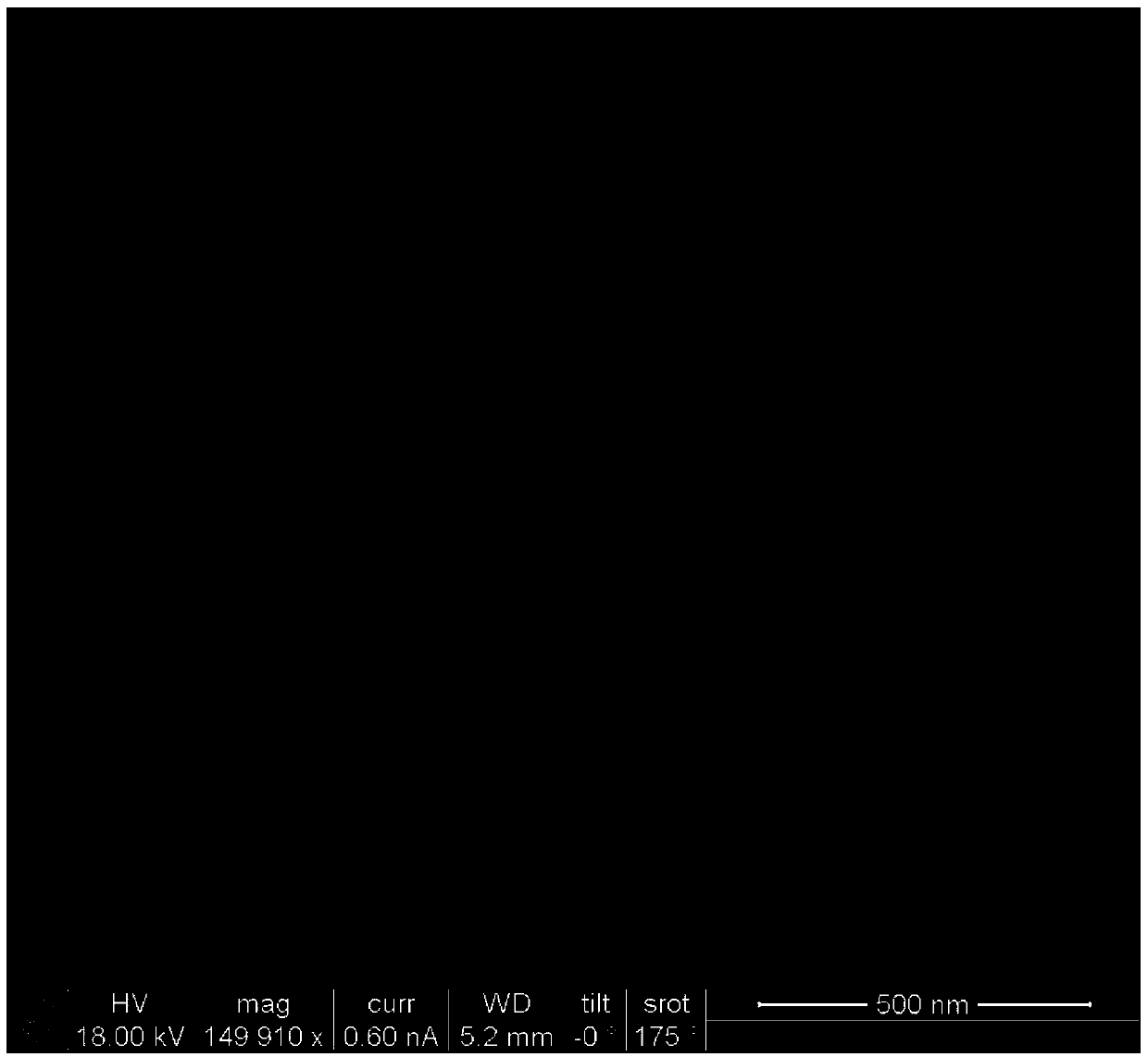Poly(p-phenylenebenzobisoxazole) porous membrane, preparation method and application thereof
A technology of benzobisoxazole and poly-p-phenylene, which is applied in the field of lithium-ion secondary batteries, can solve the problems of poor heat resistance and low strength of the separator, and achieve the effects of high tensile strength, uniform distribution and good permeability
- Summary
- Abstract
- Description
- Claims
- Application Information
AI Technical Summary
Problems solved by technology
Method used
Image
Examples
Embodiment 1
[0054] Step 1: Add poly-p-phenylenebenzobisoxazole fibers with a molecular weight of 105,000 to a mixed solvent of methanesulfonic acid (MSA) and trifluoroacetic acid (TFA) (the volume ratio of MSA and TFA is 7:3), Stir for one week under dry conditions at room temperature to form a 1% by mass poly-p-phenylenebenzobisoxazole solution.
[0055] Step 2: After the solution is subjected to vacuum defoaming treatment, it is cast into a film in an isopentane atmosphere to obtain a poly-p-phenylenebenzobisoxazole film blank.
[0056] Step 3: remove the film blank and immerse it in isopropanol at a temperature of -40°C for 4 hours, then take out the treated film blank and immerse it in deionized water at a temperature of 10°C for 4 hours to obtain Gel-state films of poly(p-phenylenebenzobisoxazole). Then the gel-state film was taken out and placed in a freezer at -50° C. for 4 hours, and vacuum-dried at this temperature for 12 hours to obtain a poly-p-phenylenebenzobisoxazole porous ...
Embodiment 2
[0059] Step 1: Add poly-p-phenylenebenzobisoxazole fibers with a molecular weight of 110,000 to a mixed solvent of methanesulfonic acid (MSA) and trifluoroacetic acid (TFA) (MSA and TFA volume ratio is 2:8), Stir for one week under dry conditions at room temperature to form a poly-p-phenylenebenzobisoxazole solution with a mass percentage of 15%.
[0060] Step 2: After the solution is subjected to vacuum defoaming treatment, it is cast into a film in an isopentane atmosphere to obtain a poly-p-phenylenebenzobisoxazole film blank.
[0061] Step 3: taking out the film blank and immersing it in deionized water at a temperature of 10° C. for 24 hours to obtain a gel-state film of poly-p-phenylenebenzobisoxazole. Then the gel-state film was taken out and placed in a freezer at -10° C. for 24 hours, and vacuum-dried at this temperature for 12 hours to obtain a poly-p-phenylenebenzobisoxazole porous film.
[0062] The obtained poly-p-phenylene benzobisoxazole porous membrane was cha...
Embodiment 3
[0064] Step 1: Add poly-p-phenylenebenzobisoxazole fibers with a molecular weight of 105,000 to a mixed solvent of methanesulfonic acid (MSA) and trifluoroacetic acid (TFA) (the volume ratio of MSA and TFA is 1:1), Stir for one week under dry conditions at room temperature to form a poly-p-phenylenebenzobisoxazole solution with a mass percentage of 10%.
[0065] Step 2: After the solution is subjected to vacuum defoaming treatment, it is cast into a film in an isopentane atmosphere to obtain a poly-p-phenylenebenzobisoxazole film blank.
[0066] Step 3: Take out the film blank and immerse it in a mixed solvent with a volume ratio of deionized water and ethanol of 1:1 for 12 hours, and the temperature of the mixed solvent is 10° C. colloidal film. Then the gel-state film was taken out and placed in a freezer at -50° C. for 24 hours, and vacuum-dried at this temperature for 16 hours to obtain a poly-p-phenylenebenzobisoxazole porous film.
[0067] The obtained poly-p-phenylene...
PUM
| Property | Measurement | Unit |
|---|---|---|
| thickness | aaaaa | aaaaa |
| pore size | aaaaa | aaaaa |
| tensile strength | aaaaa | aaaaa |
Abstract
Description
Claims
Application Information
 Login to View More
Login to View More - R&D
- Intellectual Property
- Life Sciences
- Materials
- Tech Scout
- Unparalleled Data Quality
- Higher Quality Content
- 60% Fewer Hallucinations
Browse by: Latest US Patents, China's latest patents, Technical Efficacy Thesaurus, Application Domain, Technology Topic, Popular Technical Reports.
© 2025 PatSnap. All rights reserved.Legal|Privacy policy|Modern Slavery Act Transparency Statement|Sitemap|About US| Contact US: help@patsnap.com



